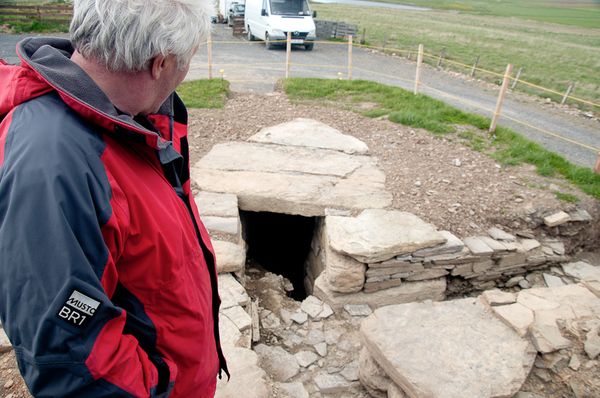
The 5,000-year-old burial site, on South Ronaldsay in the Orkney Islands, was accidentally uncovered after a homeowner had leveled a mound in his yard to improve his ocean view.
Authorities were alerted to the find in 2010 after a subsequent resident, Hamish Mowatt, guessed at the site's significance.
Mowatt had lowered a camera between the tomb's ceiling of stone slabs and was confronted by a prehistoric skull atop a muddy tangle of bones.
"Nobody had known it was an archaeological site before that," said Julie Gibson, county archaeologist for Orkney.
Partial excavation of the site, called Banks Tomb, has confirmed it as the first undisturbed Neolithic burial to be unearthed in Scotland in some 30 years, Gibson reported in June.
"It's certainly unusual to find one whose contents are so well preserved," the archaeologist said.
"We have got the assorted remains of many, many people who have been deposited in this tomb at different times."
Tomb of the Otters
The underground grave consists of a 4- by 0.75-meter (13- by 2.5-foot) central chamber surrounded by four smaller cells hewn from sandstone bedrock.
Capping the central chamber are large water-worn slabs supported by stone walls and pillars.
At least a thousand skeleton parts belonging to a mix of genders and age groups - including babies - have been found to date.
Layers of silt divide the remains, suggesting the tomb was in use for many generations, Gibson said.
The site has also been dubbed the Tomb of the Otters, because initial excavations revealed prehistoric otter bones and dung amid the human bones.
The animal remains indicate that people visited the burial site only sporadically.
"It suggests the tomb was not entirely sealed and that otters were trampling in and out a lot" throughout the tomb's use, Gibson said.
"For that to occur, you must think there was a gap of a year or two" between grave visits or burials.
Stone Age Not So "Hippy" After All?
So far the excavations, led by the Orkney Research Centre for Archaeology, have "barely scratched the surface," Gibson added.
The archaeologist is confident that the site will yield important new clues to Neolithic funerary practices.
For instance, researchers hope that DNA and isotopic analysis of the human bones will reveal if the dead were closely related and came from the same tight-knit island community or if the burials include newcomers from overseas.
Archaeologists will also investigate whether bones were removed from the tomb for ritualistic purposes.
"This burial is absolutely packed with remains, but with most [other Stone Age tombs], there are actually not that many people in them at the end," Gibson noted.
Meanwhile, recent studies of remains from the nearby Tomb of the Eagles suggest that life among Orkney's Neolithic community of cattle farmers was much less harmonious than previously thought.
At least 20 percent of skulls from that 5,000-year-old site - about a mile from the Tomb of the Otters - show signs of trauma consistent with violent blows from sharp and blunt-edged weapons.
Similar investigations are now being carried out on skeletons from the newfound site.
"Neolithic life has had quite a sort of hippy image," Gibson observed. "But it could be that we are looking at ritualized violence."



Reader Comments
to our Newsletter